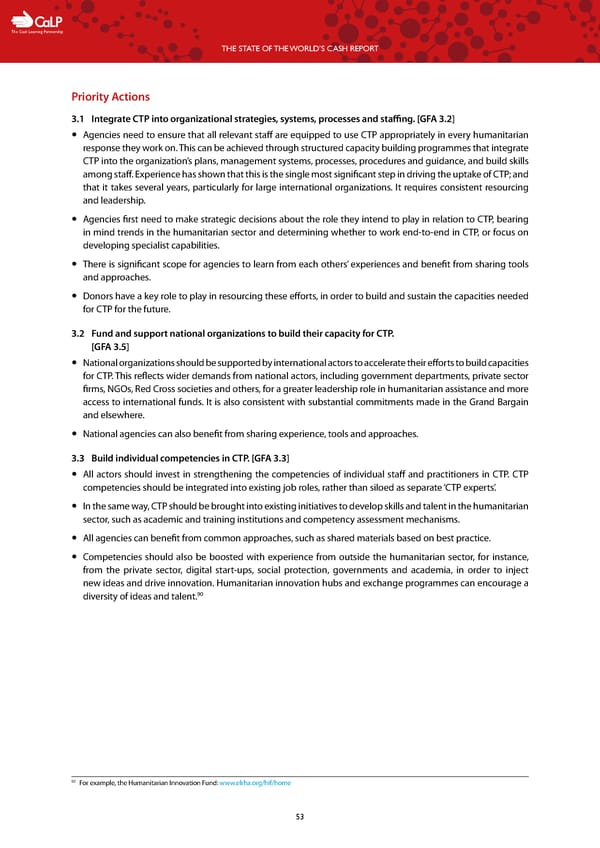C The Cash Learning Partnership THE STATE OF THE WORLD’S CASH REPORT Priority Actions 3.1 Integrate CTP into organizational strategies, systems, processes and staffing. [GFA 3.2] — Agencies need to ensure that all relevant staff are equipped to use CTP appropriately in every humanitarian response they work on. This can be achieved through structured capacity building programmes that integrate CTP into the organization’s plans, management systems, processes, procedures and guidance, and build skills among staff. Experience has shown that this is the single most significant step in driving the uptake of CTP; and that it takes several years, particularly for large international organizations. It requires consistent resourcing and leadership. — Agencies first need to make strategic decisions about the role they intend to play in relation to CTP, bearing in mind trends in the humanitarian sector and determining whether to work end-to-end in CTP, or focus on developing specialist capabilities. — There is significant scope for agencies to learn from each others’ experiences and benefit from sharing tools and approaches. — Donors have a key role to play in resourcing these efforts, in order to build and sustain the capacities needed for CTP for the future. 3.2 F und and support national organizations to build their capacity for CTP. [GFA 3.5] — National organizations should be supported by international actors to accelerate their efforts to build capacities for CTP. This reflects wider demands from national actors, including government departments, private sector firms, NGOs, Red Cross societies and others, for a greater leadership role in humanitarian assistance and more access to international funds. It is also consistent with substantial commitments made in the Grand Bargain and elsewhere. — National agencies can also benefit from sharing experience, tools and approaches. 3.3 Build individual competencies in CTP. [GFA 3.3] — All actors should invest in strengthening the competencies of individual staff and practitioners in CTP. CTP competencies should be integrated into existing job roles, rather than siloed as separate ‘CTP experts’. — In the same way, CTP should be brought into existing initiatives to develop skills and talent in the humanitarian sector, such as academic and training institutions and competency assessment mechanisms. — All agencies can benefit from common approaches, such as shared materials based on best practice. — Competencies should also be boosted with experience from outside the humanitarian sector, for instance, from the private sector, digital start-ups, social protection, governments and academia, in order to inject new ideas and drive innovation. Humanitarian innovation hubs and exchange programmes can encourage a 90 diversity of ideas and talent. 90 For example, the Humanitarian Innovation Fund: www.elrha.org/hif/home 53
 The State of the World's Cash | Full Report Page 54 Page 56
The State of the World's Cash | Full Report Page 54 Page 56